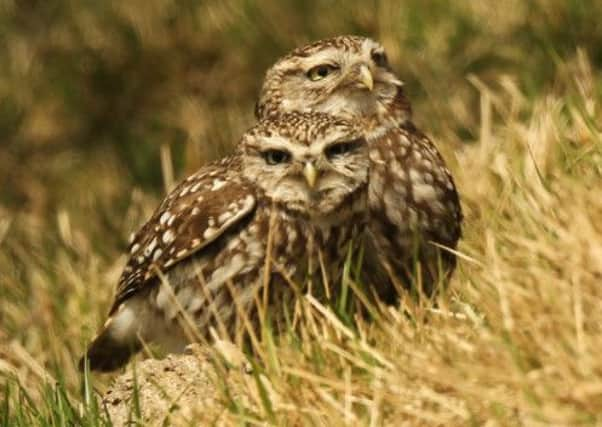Bright-eyed winged wonders return to the valley


Yet, after a cold spring last year and two bitterly cold winters before that, all but one out of five pairs of little owls living near my gallery in Thixendale have gone.
According to the Royal Society for the Protection of Birds, little owls are in decline and numbers in the UK have dropped by 24 per cent since the mid-1990s.
Advertisement
Hide AdAdvertisement
Hide AdAlthough not strictly a British owl, this pint-sized bird of prey has been with us since the beginning of the 19th century and it would be a shame to lose it.
So last month I was delighted to spot a pair in a valley opposite the gallery looking for a new nesting site. There haven’t been any little owls in this valley for two years.
I got out my binoculars to watch them as they inspected the surrounding trees for suitable holes to nest in.
Little owls are tricky to spot, but once you know what to look for you can see them. They always perch low down in trees so that they can look out for a tasty beetle or worm, and they tend to sit tight up against a tree trunk or a low branch to give them a good view of the ground below.
Advertisement
Hide AdAdvertisement
Hide AdIn late spring and early summer the shorter nights and the need to feed a growing family means they are out and about more and sometimes in mid-summer their chicks are so voracious the parents will venture out in broad daylight.
They have dappled feathers which camouflage well with the bark, but white droppings streaked down the trunk of a tree are a dead giveaway of their favourite perches.
Although little owls essentially eat insects, they will attack small mammals, particularly voles, and birds, such as sparrows and starlings and this pocket predator is even capable of tackling young rabbits its own weight.
At the end of their strong, stocky legs are talons controlled by exceptionally powerful muscles. Once these hooks lock on, they simply won’t let go.
Advertisement
Hide AdAdvertisement
Hide AdUnusually, this pair seemed to be favouring a rabbit warren for their prospective site.
I watched as they stood outside the entrance to the rabbit hole. Next they peered down into it before disappearing underground.
Little owls usually only pick rabbit holes to nest in when there are no other suitable sites. The holes, often some of them still used by rabbits, leave these small birds of prey and their eggs and chicks open to attack from stoats and rats.
I wondered why they seemed to be plumping for this option when just 70 yards away there was a large ash tree with a hole in it which I know has been used by little owls many times before.
Advertisement
Hide AdAdvertisement
Hide AdI decided to return the next day with a ladder to inspect the hole for myself. I propped it against the tree and climbed up to find it was completely blocked up with debris.
I carefully dug it out for them. Little owls are quite fussy about their nest sites, and rightly so. Being so small they are liable to come under attack from other larger birds of prey such as tawny owls, buzzards and sparrow hawks.
Jackdaws also compete with them for nesting sites. I once watched six jackdaws trying to push a pair of little owls from a prized site. And they will even take their eggs if they find their nests.
To be safe, little owls choose long, small holes, preferably with a few bends and turns in it, that only they can fit down. They also need a chamber at the end for the nest.
Advertisement
Hide AdAdvertisement
Hide AdBy the time I had finished clearing the hole it was two feet long and difficult for me to get my arm down – perfect for a nesting pair of little owls.
Before I left I set up a hide opposite the tree on the daleside near the rabbit holes so that I could watch what happened next.
I got into the hide early the next morning and waited. It wasn’t long before the pair arrived at the rabbit hole.
It had been a cold night and I watched as they settled in a patch of sunlight on a spoil heap outside the hole. They began preening one another as they warmed up in the sun. I took the opportunity to take some photographs.
Advertisement
Hide AdAdvertisement
Hide AdLittle owls make great painting subjects. Their short dumpy silhouettes are unmistakably ‘cute’.
This pair were exceptionally so as they leaned against one another, their heads tucked up close like lovers in a park.
After lunch one of the owls flew up to the ash tree to hunt for beetles. I held my breath as it passed my newly renovated hole. The little owl spotted it and promptly disappeared into it and out of sight.
It was only gone for a short while before it popped out again and called to its mate to come across and take a look. They both then disappeared into the hole for a few minutes.
Advertisement
Hide AdAdvertisement
Hide AdAs they came back into view they began to call to one another and then to mate. I slowly let out my breath. Clearly they were pleased with my clearing up job and had decided to move in.
I have only seen one this week so I’m hoping the female is sitting on some eggs. I will be keeping a close eye on what happens next. If all goes well we could have some chicks fledging by June and fingers crossed there will be enough to begin to repopulate the area.